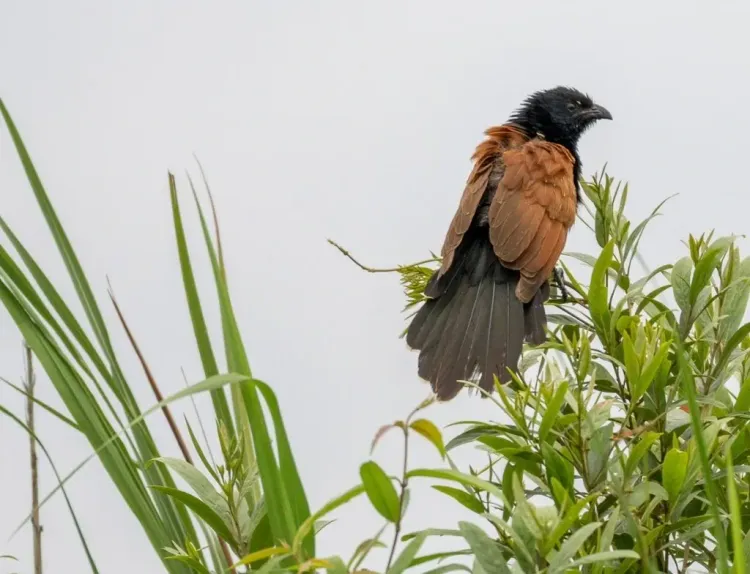What Did the Recent Survey Reveal About Grassland Birds in Assam?

Synopsis
Key Takeaways
- 43 grassland bird species identified in Kaziranga.
- Includes critically endangered, endangered, and vulnerable species.
- Survey highlights the ecological significance of the Brahmaputra floodplains.
- Passive acoustic monitoring aids in non-invasive species tracking.
- Collaboration among experts is key to effective conservation.
Guwahati, July 14 (NationPress) In a remarkable turn of events, a recent survey conducted at the renowned Kaziranga National Park and Tiger Reserve (KNPTR) in Assam has identified a total of 43 grassland bird species, as announced by officials on Monday.
The survey revealed that among the 43 grassland bird species, there is one critically endangered, two endangered, and six vulnerable species, alongside various species that are endemic to the region, according to the International Union for Conservation of Nature (IUCN) Red List.
KNPTR Director Sonali Ghosh highlighted that the survey, which took place from March 18 to May 25, focused keenly on ten key species that are either globally threatened or endemic to the Brahmaputra floodplains.
These at-risk or endemic species include the Bengal Florican, Swamp Francolin, Finn’s Weaver, Swamp Grass Babbler, Jerdon’s Babbler, Slender-billed Babbler, Black-breasted Parrotbill, Marsh Babbler, Bristled Grassbird, and Indian Grassbird.
The survey report marks a significant achievement in documenting and safeguarding grassland-dependent bird species in the Brahmaputra floodplains, as stated by the KNPTR Director.
Spanning the Eastern Assam, Biswanath, and Nagaon Wildlife Divisions, the extensive survey utilized a mix of point count surveys and passive acoustic monitoring, representing a pioneering effort to evaluate grassland avifauna within this ecologically vital area.
Assam’s Environment, Forest and Climate Change Minister Chandra Mohan Patowary expressed great enthusiasm regarding the identification of 43 grassland bird species.
In a post on X, he shared: “I am thrilled to announce that Kaziranga’s inaugural grassland survey has recorded 43 grassland bird species, including one critically endangered, two endangered, and six vulnerable species, plus several regional endemics.”
He further noted: “The Brahmaputra floodplain ecosystem showcases the highest diversity of grassland obligate birds in India, indicative of the habitat’s robust health and effective conservation. Our commitment to science-based management remains unwavering!”
Director Ghosh pointed out that a key highlight of the survey was the discovery of a breeding colony of the endangered Finn’s Weaver (Ploceus megarhynchus) at Kaziranga. This extraordinary bird, a lifer for many birdwatchers, is a crucial indicator of grassland health.
According to Ghosh, these species act as ecological indicators of the health and integrity of floodplain grasslands. An additional important aspect of the study was the use of passive acoustic recorders, facilitating non-invasive and continuous monitoring in challenging or high-risk areas.
Ghosh emphasized that the report identifies several critical grassland habitats within Kaziranga that host significant populations of threatened and endemic species.
Notably, the identification of a breeding colony of the Endangered Finn’s Weaver in the Kohora Range is a pivotal finding that underscores the necessity for targeted habitat protection and management.
The report stems from a collaborative effort among dedicated forest officials, bird experts, scientists, and conservationists, according to official sources.
Environment, Forest and Climate Change Minister Chandra Mohan Patowary unveiled the survey report at an event in Kaziranga, commending the Park authorities for documenting lesser-known facets of biodiversity.
Ghosh remarked that this report signifies a crucial initial step towards the long-term conservation of grassland birds, reiterating the need for ongoing ecological monitoring and adaptive management to protect these delicate ecosystems.
This groundbreaking work reaffirms Kaziranga’s role not just as a sanctuary for charismatic megafauna but also as a vital refuge for avian biodiversity within the Indo-Burma biodiversity hotspot.
The KNPTR, recognized as India’s seventh UNESCO World Heritage site, comprises three forest divisions: the Eastern Assam Wildlife Division, Bokakhat; the Bishwanath Wildlife Division, Biswanath Chariali; and the Nagaon Wildlife Division, Nagaon.
Home to a remarkable population of the Big Five, it includes 2,613 Greater One-horned Rhinoceroses as per the 2022 census, 104 Bengal Tigers, 1,228 Asian Elephants, 2,565 Wild Water Buffalos, and 1,129 Eastern Swamp Deer, all recorded in 2022.








